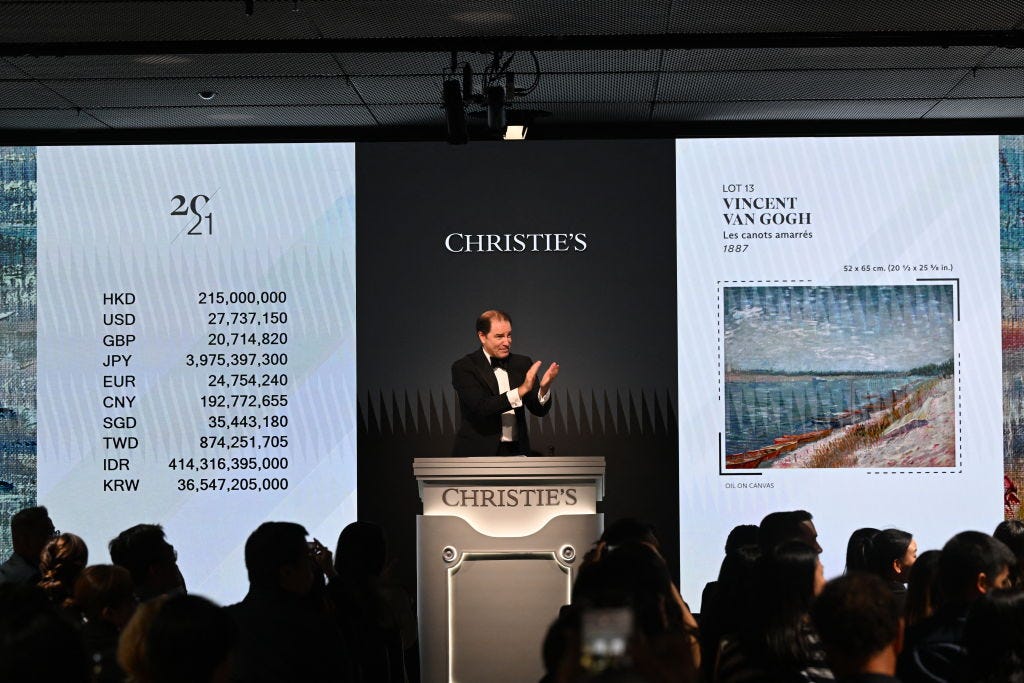
The last two years have been bumpy rides for the art business. Markets go up and down, and companies come and go, but auction houses have evolved their business model only slightly since the 18th century. Yet, the quantity of sales (and lots) has reduced over the past decade, begging the question, how is the auction business changing?
As 2024 drew to a close, of the two large auction houses, Sotheby’s appeared to have suffered more than Christie’s. The owner of Sotheby’s is the French-Israeli billionaire Patrick Drahi, whose main holding company Altice is saddled with large amounts of debt — reportedly in excess of $50bn.
At the end of last year, Drahi completed a deal with ADQ, one of Abu Dhabi’s sovereign wealth funds, raising some $1bn through the sale of stock, which will go to pay down some of Sotheby’s $1.6bn of debt.
As one half of the great duopoly of global auction houses, Sotheby’s is clearly seeking a fresh approach.
Last year in an attempt to boost revenue and simplify a notoriously complex fee system, Sotheby’s revised its commission structure. This was a deeply unpopular move, and Sotheby’s soon realised it was driving sellers into the arms of its arch-rival Christie’s. So from February 2025 Sotheby’s will revert to a negotiable seller’s commission.
On the plus side, it sold $300m more than Christie’s, its total sales reportedly $6bn versus Christie’s haul of $5.7bn. Both figures represent a drop from 2023 and a major slide from the high of 2022, when Christie’s sales total reached a record $8.4bn.
However, what is interesting is the apparently astonishingly small net profit on those large turnover figures. As privately-owned companies, neither is obliged to publish accounts, and thus release selected data which include annual sold totals, but not net profit.
With such small profits from gigantic total sales, is there financial sense in owning an auction business?
Some have speculated that annual net profit is in the region of just 2 per cent — for 2024 around $100–120m.
With such small profits from gigantic total sales, is there financial sense in owning an auction business? Drahi bought Sotheby’s in 2019 for $3.7bn and in 2018, when it was a public company, reported $108m net profit. Christie’s was bought in 1998 by Francois Pinault for $1.2bn. Annual profits in the 1990s were running at $60m but had jumped to about $200m by 1997 on a turnover of just over $1.6bn. Sotheby’s figures were broadly comparable.
In 1999, Pinault’s fellow Frenchman and rival in business Bernard Arnault, perhaps not wishing to be outdone, bought Phillips for a reported $100m. Phillips was (and remains) the “third” — much leaner — auction house.
Arnault’s strategy was to “buy” market share by offering financial incentives to sell modern pictures through Phillips with a view to bringing it level with Sotheby’s and Christie’s. The strategy did not work, and after losing hundreds of millions in guarantees, he offloaded the auction house in 2003.
Now owned by a Russian investment vehicle The Mercury Group, Phillips specialises in a few, mostly modernist categories: 20th and 21st century pictures, photographs, jewellery, watches and modern prints.
This leaner, more focused model perhaps gives a good indication of what the future of the global duopoly of Christie’s and Sotheby’s auction businesses may look like.
Certainly, the Sotheby’s move to a boutique building on Madison Avenue fits with its desire to be seen as a purveyor of luxury goods. Christie’s, on the other hand, is sitting back and watching. Arguably, Christie’s is in a perfect position, with little or no debt, and the support of the deep-pocketed Pinault family.
Perhaps owing to global instability, wars, elections, the slowing of Asian buying and — in my view, most significant of all — continued high interest rates, the appetite for buying and selling art has slowed in the past two years, and this reluctance to buy was reflected in a lower global auction sale total for 2024 for the big two.
However, their business model now includes private sales — Christie’s refers to itself as an art business, not merely an auction house. In 2024 Christie’s reported a 41 per cent increase from 2023 in private sales, to $1.5bn or 26 per cent of total annual sales.
From a business standpoint, without any of the overhead of cataloguing and marketing, nor giving back a per centage of the buyer’s premium, private sales may be the most profitable route to sale for these large businesses.
Auctions will always have a place in the art market, even though they may not be the most profitable for the biggest sales. Could we see a gradual transformation of the two large auction houses into dealers?
This article is taken from the February 2025 issue of The Critic available here



